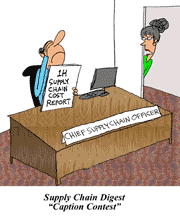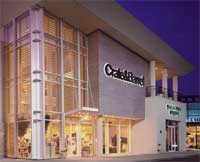 |
September 13, 2013 - Supply Chain Newsletter |
 |
| FEATURED SPONSOR: HIGHJUMP |
 |
Make a Truly Informed Buying Decision |
 |
|
|||||||||||||||||||||||||||||||||||||||||||||||||||||||||||||||||||||||||||||||||
Trip Report: Material Handling and Logistics ConferenceI am just a couple of days back from the 2013 Material Handling and Logistics Conference at the beautiful Canyons resort in the mountains of Park City, UT.
The conference felt well-attended, with some 450 attendees, a solid number for this type of event. Dematic was good enough to get me out there for a presentation (on eFulfillment), and that plus a solid line-up of other presentations makes a trip report on the event well-justified. Dematic is a materials handling automation vendor, but the content covers a broad array of more general supply chain and logistics topics. |
||||||||||||||||||||||||||||||||||||||||||||||||||||||||||||||||||||||||||||||||||
|
||||||||||||||||||||||||||||||||||||||||||||||||||||||||||||||||||||||||||||||||||
|
||||||||||||||||||||||||||||||||||||||||||||||||||||||||||||||||||||||||||||||||||
|
|
|
YOUR FEEDBACK
We received quite a bit of Feedback on guest columnist David Schneider's two-part series on Systems Thinking in the Supply Chain - or lack thereof. So much so we might have enough for a "Reader's Respond" column in a couple of weeks.
We publish a few more of those letters here this week.
Feedback of the Week - On Systems Thinking in the Supply Chain
Do you agree or disagree that companies often don't use systems thinking to guide supply chain decisions? Why or why not? I agree. I began my career in systems in 1965 and recall encountering few instances of systems thinking and even fewer instances of causal loops. I hypothesize two reasons for this. First, systems thinking ã la Forrester is not encountered all that frequently in business and even less so in general. I suppose one may give systems thinking the Rumsfeldian label of an Unknown Unknown. It's difficult to apply, or even consider, something that you don't know you don't know. Second, systems thinking, properly applied, exposes what you don't know. To borrow from Twain, it also exposes what you know that just ain't so. It further uncovers variables for which a sensing mechanism may not exist. Ergo, systems thinking is hard work that provides plenty of embarrassing moments as one moves to understanding and subsequent resolution of the issue. This is not for the faint of heart and feeble of mind. I teach a course in System Design and Control where the two texts are Sterman, J. (2000). Business Dynamics: Systems Thinking and Modeling for a Complex World. Boston and Supply Chain Council. (n.d.). Supply Chain Operations Reference (SCOR) Model: Overview, Version 10.0 to examine contemporary supply chain issues. The December 2011 decision by China to apply tariffs on automobiles imported from the US is example of such an issue. Ever used a causal diagram? Oh, yes. hardly a week goes by without a little sketch on some issue I'm dealing with. I've Vensim on my computers and often open it up to raw loops. James Drogan |
||
| More Feedback on Systems Thinking | ||
David is right on point regarding the application of systems thinking to the planning and execution of the many facets of the integrated supply chain. I have attempted to employ the systems approach to a variety of challenges since reading some of the works of one of the early advocates of the systems thinking by the late C. West Churchman (i.e. The Systems Approach and the follow-on The Systems Approach and its Enemies). The Causal Diagram and some of the Lean Sigma tools (e.g. Value Stream Mapping) are indeed keys to the implementation to this approach. Two additional requirements are that an individual have be prepared to do perform a thorough analysis without leaping to what may be erroneous results and that the individual/team have an understanding of the process including those areas directly impacted and those only tangentially related. It is this latter requirement that makes it particularly suitable to the supply chain process as it has impacts across most if not all of the various functions and silos within an organization. Thank you for your column. It is always good to be reminded of the fundamental need for systems thinking within our profession.
Millard Humphreys
|
||
This is excellent. Whether or not DC management (as an example group) utilizes system thinking or not can make or break a facility. I've seen it as you have (both positive and negative).
|
||
The problem I see is that there is rarely one person who is responsible for all of this. You have elements of marketing forecasting, purchasing, transportation, distribution, etc., involved. In the real world one of the big reasons that people don't think this way is that there are a lot of fiefdoms in play and no one is sharing their time and effort to look at the big picture. If you get these various hats all in the same room together periodically and just communicate - that is the key.
|
||
SUPPLY CHAIN TRIVIA ANSWER
Q: About how much would a 13,000-TEU container ship spend in bunker fuel on a trip from Asia to Europe and back?
A: Roughly $4.7 million, if traveling about 20 knots there and 14 knots back, according to Drewry Shipping research. That would be about $333 per TEU, or $666 for a 40-foot container. Who knew?
| © SupplyChainDigest™ 2003-2013. All Rights Reserved. SupplyChainDigest PO Box 714 Springboro, Ohio 45066 |
POWERED BY: XDIMENSION
|









